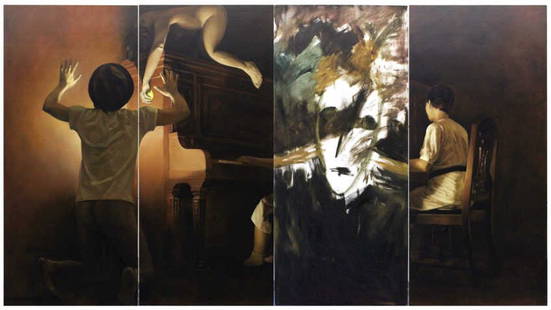
Painting by Brachi Horen "Reading The Megilah"
Similar Sale History
View More Items in Mixed Media & Collages
Related Mixed Media & Collages
More Items in Mixed Media & Collages
View MoreRecommended Art
View More



Item Details
Description
Mixed Media Painting using watercolor and 24k gold gilding by Brachi Horen | Entitled Reading The Megilah | Hand signed by the artist Brachi Horen | Professionally custom framed using acid free materials and is ready to hang | Includes Certificate of Authenticity | Measures approx. 30W x 38 H About Brachi Horen: Born in Jerusalem in 1981, Brachi Horen spent her formative years working under the renowned artist Sylvia Bar-Am, winner of the Israel Prize for Art. Horen credits these interactions for sharpening her technical skills as an artist, but also states that she inherited Bar-Am's drive for expressing truth through the medium of art. With time, Horen branched out and her expertise widened under the tutelage of other famous artists such as Chasya Leshinsky, Binyamin Bustiker and Penina Frank. Perhaps her most important professional relationship is with the world renowned artist Yitzhak Holtz, a relationship Horen says continues to influence her direction in the world of art. In addition to Horen's oil paintings of the Holy Land, she also creates parchment sketches, bringing to life biblical and authentic Jewish scenes. At times, she integrates these pieces with biblical verses and Jewish prayers. These parchment sketches combine various artistic techniques such as ink, water color and charcoal sketches, including gilding with 24 carat gold leaves. About Reading the Megilah: The Scroll of Esther, known as the Megillah, is chanted in the synagogue on the eve of Purim and again the next morning. It is the last of the five scrolls that form part of the third division of the Bible, known as the Ketuvim, or Writings. Megillat Esther tells the story of the salvation of the Jews of the Persian Empire. The Scroll of Esther is universally known as the Megillah, not because it is the most important of the five scrolls, but due to its immense popularity, the prominence that is given to its public reading, and the fact that it is the only one that is still generally read from a parchment scroll. At one time, it was normative for every Jewish household to possess a Megillah, and much time and skill were devoted to the production of beautifully illuminated texts and elaborate wooden and silver cases that would house the scroll. The primary synagogue observance connected with Purim is the reading of the Book of Esther, called the Megillah (scroll). It is traditionally read twice: in the evening, after the Amidah prayer of the Maariv service and before the Aleinu, and in the morning after the Torah reading. The Megillah is read from a parchment scroll that is written the same way a Torah is written by hand, with a goose quill. If there is no such scroll available, the congregation may read the Book of Esther from a printed text, without the accompanying benedictions. The Book of Esther is chanted according to a special cantillation used only in the reading of the Book of Esther. [This cantillation parodies the tropes used for reading at other times of the year.] If no one is present who knows this cantillation, it may be read without the cantillation, as long as it is read correctly. According to the Code of Jewish Law (Orach Chayim 690:9), it may be read in the language of the land. In practice, however, the usual custom is to chant the Megillah from the scroll in its original Hebrew. Before the reading, the custom is to unroll the scroll and fold it so that it looks like a letter of dispatch, thus further recalling the story of the great deliverance. The Megillah must be read standing and from the scroll, not by heart. During the reading, there are four special verses, called verses of redemption (pesukei ge'ulah) that are [traditionally] said aloud by the congregation and then repeated by the reader. [Esther 2:5, 8:15-16, 10:3] At certain key points in the Book of Esther, it is a custom for the reader to raise his or her voice, adding drama to the story. [Esther 1:22, 2:4, 2:17, 4:14, 5:4, 6:1. In this last verse the king cannot sleep and commands that the book of records of chronicles be read to him. This is considered to be the turning point in the Esther story.] Another interesting part of the chanting of the Book of Esther is the four verses (Esther 9: 7-10) enumerating the 10 sons of Haman. The custom, already mentioned in the Talmud (Megillah 16b), is for the reader to chant the names of Haman's sons in one single breath, in order to signify that they died together. Another reasons for this custom is the fact that we should avoid the appearance of gloating over their fate, even though it was deserved. It is a widespread custom for the listeners at the Megillah reading to make noise, usually with special noisemakers called graggers, or in Hebrew ra'ashanim, whenever Haman's name is mentioned. Some congregations also encourage the use of wind and percussion instruments as noisemakers. The custom of blotting out the name of Haman appears to be the outgrowth of a custom once prevalent in France and Provence, where the children wrote the name of Haman on smooth stones, then struck them together whenever Haman was mentioned in the reading so as to rub it off, as suggested by the verse “the name of the wicked shall rot” (Proverbs 10:7). Many modern-day congregations today are known to hold concurrent readings of the Megillah, each reading specially tailored to a particular age group or level of understanding. The singing of Purim songs during the reading of the Megillah, dressing up in costume, and other acts of frivolity are also part of today's modern Megillah-reading festivities. Excerpted with permission from Every Person's Guide to Purim (Jason Aronson).
Dimensions
38 x 30 in
Buyer's Premium
- 22% up to $499.00
- 24% up to $1,000,000.00
- 26% above $1,000,000.00
Painting by Brachi Horen "Reading The Megilah"
Estimate $550 - $850
1 bidder is watching this item.
Get approved to bid.
Shipping & Pickup Options
Item located in Gallatin (Nashville), TN, usSee Policy for Shipping
Local Pickup Available
Payment
Accepts seamless payments through LiveAuctioneers

TOP













































































